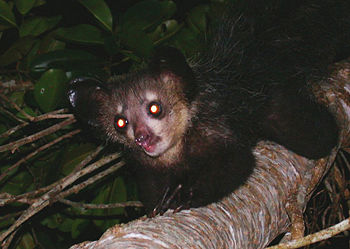Aye-aye: Difference between revisions
imported>Amanda Quinn mNo edit summary |
imported>Amanda Quinn No edit summary |
||
| Line 51: | Line 51: | ||
=== References === | === References === | ||
Allan, Tony & Mark Salad, ed. ''The Encyclopedia of Mammals.'' Andromeda Oxford Limited, (c) 2001. | |||
Cohn, Jeffrey P. ''Bioscience'' "Madagascar's mysterious aye-ayes". Vol 43, issue 10. (c) 1993. | |||
Corliss Pearl, Mary. ''The Illustrated Encyclopedia of Wildlife.'' "Prosimians: Lemurs, Bush Babies, Tarsiers, etc." Grey Castle Press (c) 1991. | Corliss Pearl, Mary. ''The Illustrated Encyclopedia of Wildlife.'' "Prosimians: Lemurs, Bush Babies, Tarsiers, etc." Grey Castle Press (c) 1991. | ||
Revision as of 18:27, 7 April 2008
The Aye-aye is the sole living member of the family Daubentoniidae. Aye-ayes are a type of lemur and are quadrupedal leapers and clingers. They are found only in Madagascar and are the largest nocturnal primate in the world. Like many primates today, their survival is threatened by loss of habitat and human predation.
Physical Characteristics
The physical appearance of Aye-ayes is extremely unique. They are about the size of a cat and weigh 2.4-2.8kg (5-6lbs)[1]. Aye-ayes do not exhibit sexual dimorphism. They have large ears and long, bushy tails. Their coat is grey-black with white tips and their digits are elongated, especially the middle fingers. Aye-ayes have a reflective tapetum that helps them detect light at night and makes their eyes shine like a cat's do when you shine a flashlight at them.
The front teeth of Aye-ayes grow continuously like a rodent's -- a unique trait among primates. These large, powerful incisors help them tear through wood to get to the grubs they like to eat so much. They also use their teeth to eat the tough fruits they like, such as coconuts.
Their appearance is so strange that the people of Madagascar are afraid of them and consider them to be a bad omen.
Habitat
Aye-ayes live in forests in Madagascar, mainly on the Eastern coast. They spend most of their time in trees, and build nests to sleep in during the day.
Diet
Aye-ayes take over the ecological niche that woodpeckers usually occupy in other areas of the world. They use their especially long middle fingers to forage for food by tapping them on things like wood. They then use their large ears to listen to the sound the wood makes in order to find hollow spots where larvae live. They will then use their long incisors to tear a hole in the wood and fish out the larvae with their middle finger. Aye-ayes eat mainly larvae, nuts, and fiberous fruits such as coconuts and mangoes. They therefore are categorized as omnivores.
Aye-ayes will sometimes raid plantations for food. Because of this fact, farmers often do not like them and will kill them.
Behavior
Aye-ayes are mainly solitary creatures. Tracking them in the wild requires following them through the forest during the night when they're active. As can be guessed, this is a difficult task and so some portions of the Aye-ayes life are still not well-known. For example, lifespan in the wild is not well known, but in captivity they usually live to be about 23 years old. Male ranges are larger than those of females and regularly overlap female ranges.
As they travel, Aye-ayes will leave marks using either their scent glands or urine to communicate with others of their species.
Reproduction
Sexual maturity for Aye-ayes occurs at about 2-3 years of age. When they're in estrus female Aye-ayes will call repeatedly to get the attention of males. Visual cues such as genital color change and swelling also alert males to the female's estrus. Aye-ayes are polyandrous, meaning that the females mate with several males. They usually only have one infant and gestation ranges from 160-170 days or about 5-6 months. Infants are weaned after 7 months and leave their mothers after two years. While hunting during the night, female Aye-ayes leave their infants "parked" in the nest.
Conservation
Aye-ayes were once thought to be the most endangered species of lemur, but have been spotted in more areas of Madagascar than most other types of lemurs in recent years. Even so, in an effort to ensure that adequate numbers of Aye-ayes exist, captive breeding programs have been created in four countries [2].
Classification
Kingdom: Animalia
Phylum: Chordata
Class: Mammalia
Order: Primates
Suborder: Prosimii
Family: Daubentoniidae
Genus: Daubentonia
Species: madagascariensis
References
Allan, Tony & Mark Salad, ed. The Encyclopedia of Mammals. Andromeda Oxford Limited, (c) 2001.
Cohn, Jeffrey P. Bioscience "Madagascar's mysterious aye-ayes". Vol 43, issue 10. (c) 1993.
Corliss Pearl, Mary. The Illustrated Encyclopedia of Wildlife. "Prosimians: Lemurs, Bush Babies, Tarsiers, etc." Grey Castle Press (c) 1991.
Gron KJ. 2007 July 27. Primate Factsheets: Aye-aye (Daubentonia madagascariensis) Behavior. [1]. Accessed 2008 March 21.
Kite, Lorien. Nature's Children: Lemurs. Grolier Educational (c) 1999.
Massicot, Paul. Animal Info - Aye-aye. [2]. Animal Info (c) 1999-2000
